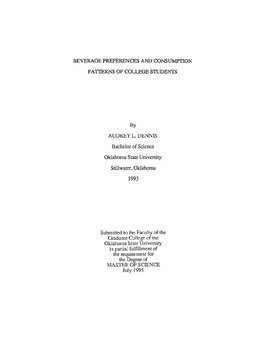| dc.description.abstract | Food consumption has been a highly researched area in recent years except for beverages. Over 60% of Americans consume some sort of food or beverage between meals (Pao & Mickle, 1980). Beverages have become a growing market in the United States in the 90's with new products emerging yearly. Some of the newest products introduced to the market are specialty coffee, iced coffee. sports drinks, "New Age" dear beverages (Scarpa, 1993) and bottled water (Green, 1984). Eating habits develop early on in adolescence and are influenced by geography, economic & technological development, cultural determinants, religious taboos, ethnicity, marketing and peers to name a few (Gordon, 1983). A report published by the Office of Disease Prevention & Health Promotion, a division of the Department of Health & Human Services, listed improved nutrition as one of the 21 identified strategies to improve the nation's health (DHHS, 1991). High priority was placed on improving nutrition practices to reflect the dietary guidelines for Americans (USDA, 1990). One of the objectives is to avoid too much sugar, and the other, to drink alcoholic beverages in moderation. College students represent an important segment of the United States population and their food and beverage consumption should be assessed in as much as students are generally under stress, have limited funds, and limited time to purchase and prepare meals (Khan & Lipke, 1982). Carbonated and alcoholic beverages are an integral part of the college students food consumption (Khan & Lipke, 1980; Nelson & King, 1982; Hernon, Skinner, Andrews, & Penfield, 1986; Kidorf, Lang & Pelham, 1990). This is of particular concern to nutritionists and dietitians because students tend to follow low- caloric diets, avoid nutritious foods, and skip meals (Hernon et al, 1986). Serious consequences can result from these practices and be further aggravated by emotional problems and physical stress, while attending the University. As nutrition educators, we need to ascertain the types of beverages preferred by college students. In addition, we need to discern their nutrition knowledge towards the consumption of beverages to more accurately and effectively develop educational tools to enhance knowledge of and compliance of the new dietary recommendations (Axelson & Brinberg, 1987). | |
